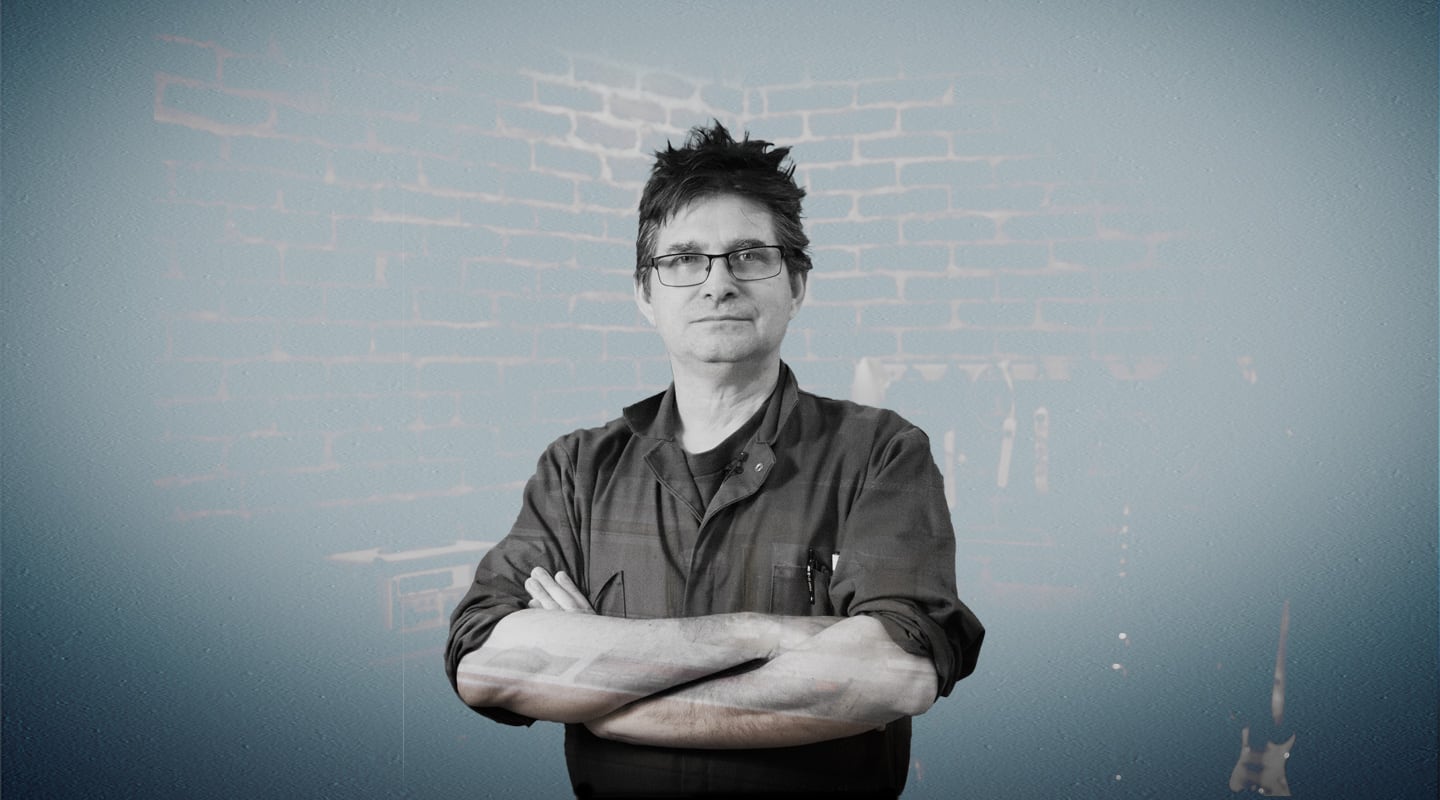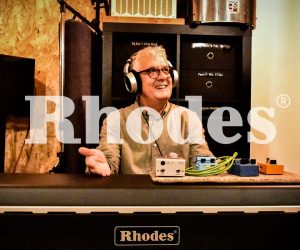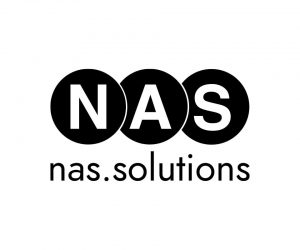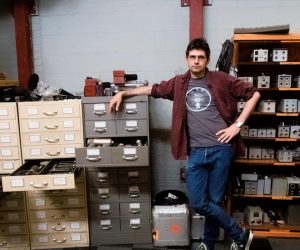
Steve Albini: On Tape
Two weeks before Electrical Audio’s 20th anniversary shindig, AudioTechnology visited the Chicago studio and found out why Albini still uses tape.
I arrived two weeks early, it seems. 2017 marked the 20th anniversary of Steve Albini’s studio Electrical Audio, and when I caught a cab up the i90 from Downtown Chicago to spend time with Albini, the date was all set for a celebration with a bunch of bands at the Hideout… two weeks from the day.
No matter, I’m there for the Fluffies and the banter. I’d have to settle for the latter, as Albini’s fellow engineer, Greg Norman, was fresh out of civet-pooped coffee. Instead I sipped on some water and listened to he and Albini argue about the price of college in the ’80s.
“Northwestern, where you went, is about 30 grand a year,” said Norman.
“When I was there it was almost 40 grand a year,” replied Albini. “So it’s got to be more now.”
“In what, 1980? No way, I’ll bet you a hundred dollars it wasn’t.”
“Okay. I’m the one who had to pay the loans.”
“’80-’84? $100.”
“Dig it up.”
10 minutes later… after Albini has walked me through a bleak picture of federally guaranteed loans, barber colleges that cost as much as going to Princeton, students saddled with insurmountable debt, and the impetus for Donald starting Trump University, Norman chips back in: “In 2011-12 it was $41k!”
“Sounds about the same, I’m probably thinking of the total costs…”
“Moving those goal posts way back.”
FROM BUNGALOWS TO CONDOS
It’s classic smoko chatter. Albini even wears a daily uniform of Electrical Audio-branded coveralls, a visual reminder that his focus is on engineering recordings, not artisan-crafting them. The brown brick building Electrical Audio inhabits fits the workmanlike operation to a ‘t’. It was built at the turn of the 20th century, barely newer than the Lutheran church down the road. All of the ground floor windows and doorways have been bricked in, leaving just one solid door access. On either side of the studio are apartment buildings, but Albini said it wasn’t so well-established 20 years ago.
Back in December ’95 “it was essentially a vacant, industrial neighbourhood,” recalled Steve. “Across the street was a big, empty, abandoned building that used to be The Valley Pinball Company. This building was cheap and there was room for me to build two studios in it.”
Then the condos started rising out of the rubble of the industrial complex. First to go was the pinball company, then the warehouse to the west, and a printing press plate manufacturer to the east.
Albini nabbed the joint for just shy of a quarter of a million back then, after a handful of high-paying jobs gave him enough capital.
Albini has always been in the neighbourhood. His first studio was a bungalow a mile from Electrical Audio that he bought in ’86. He built an eight-track recording studio there, where “Big Black recorded its final recording sessions for our final album,” said Albini.
He started recording friend’s bands too, and soon enough, “I started getting engineering gigs outside my circle of friends from people I’d never met.” In the winter of ’87/’88 he was able to quit his job to become a full-time recording engineer, working mainly out of the house with occasional trips to other studios.
He saved money to buy more equipment then rebuilt the studio. “I bought a larger console, a 24-track machine and a bunch of outboard equipment,” he said. “I rebuilt the studio so the entire attic was a control room, and the basement remained the playing rooms.”
Demolition and construction started immediately in ’95, and it wasn’t until April ’97 when Albini recorded his first session there. After the building purchase, Albini had enough money to “finish off one studio of the two planned for the building. Then I moved the studio into the first-floor Studio B control room, sold my house, sunk all that money into building Studio A and started making records in Studio B.”
Albini’s name is linked to big-name acts like Nirvana, Pixies, Low and PJ Harvey, but his discography is packed with acts of all shapes and persuasions, many of them local to the Chicago area. He stops short of calling his work a documentarian-like effort, but he does appreciate the work and its connection to his hometown. “I’ve done a lot of Chicago bands but by no means a definitive portrait of the city,” assessed Albini. “Over the course of 20 years, a lot of people have had a chance to cycle through the studio. I’m in favour of staying in business. I love it that as a studio we are a resource for the local music scene. It makes me feel validated in building the place in the first place. But we don’t depend on the Chicago music community for our life blood. We have an international clientele. If we had to depend purely on the local business, we would have failed a long time ago.”

THROWING MUD
Albini took me on a tour of the facilities, starting with Centrefield. The roughly diamond-shaped, baseball-inspired large live room. The walls are constructed out of adobe, an unfired earth brick from the southwest of the US. Albini got the idea when he was doing a session at Mick Wordley’s studio, Mixmasters in Adelaide. At the time, Mixmasters was in Mick’s house, but he was in the throes of building a new studio out of mud brick, and invited Albini to have a look. “As soon as I saw people working with it I thought, ‘Wow, this is the perfect material to build a studio out of.’ It’s dense, it’s soft, the walls will be self-isolating — that’s really, really smart.”
Back in the US, he pored over earth building journals in order to become conversant in mud technology, then bit the bullet and trucked tens of thousands of bricks up to Chicago.
“The great thing about adobe is it’s an extremely forgiving material,” explained Albini. “The mud of the grout lines between the bricks becomes contiguous with the mud of the bricks themselves and acts like one solid pile of mud. The whole wall tends to settle in a way that eases its own internal stresses and avoids cracking the way more rigid masonry does.”
The key point, Albini stresses, is that if you were to hit a traditional brick with a hammer it would transmit the vibration of the hammer and ring like a bell, whereas adobe will absorb the energy with a thud. It’s really good at sound isolation. The result is Electrical Audio can have two studios operating on the same floor with minimal bleed. “We can have a roaring heavy metal band operating here late into the night and the people sleeping in the apartments next door never hear it.”
Albini flew a professional adobe brick layer in from New Mexico to show some professional masons and his ragtag group of friends how to lay the brick. “Within a week, our crew of layabouts and fools — just normal, regular people who’d never laid a brick in their lives — were doing it.” You can see it in two of the opposing walls; one is professionally even and square, while the other is a lot more haphazard. That one was by the “self-taught, punk rock construction crew.” Albini himself laid no more than a dozen adobes.
The remainder of the studio is comprised of another smaller live room called Kentucky, and Alcatraz, which is a prison for sound waves, designed to minimise the harm of loud guitar amps.
I feel like all the digital sessions don’t have that fundamental element of permanence. They drop the ball on what, to me, is the most important part of the job

TAPE DOWN THE HATCHES
The control room is spacious, with plenty of space to house the battery of analogue gear and two core tape machines that record everything that transpires at Electrical Audio — a Studer A820 multi-track two-inch tape machine and an Ampex ATR102 1/2-inch machine for mixdown.
It’s been 20 years since Albini started the studio, and digital audio has become the predominant recording format. So, why does he continue to hold out and use tape?
Albini says it’s for both practical and aesthetic reasons. Let’s take practical first. Albini explains it by using Robbie Fulks as an example. When he first recorded the singer-songwriter back in ’85, Fulks had no national profile to speak of. Last year, he was nominated for two Grammy awards. Now that Fulks has achieved significant status, “it’s not inconceivable that someone will want to do a compendium of his music,” reckons Albini. “If I had recorded his sessions on the digital format of the day, it would be impossible to resurrect those sessions in any meaningful way.” Now, he can just lace up those original tapes on the machine and mix any outtakes of interest. “I’ve already been involved in the silver anniversary editions of several records I recorded,” said Albini. “The master tapes having survived allowed them to be presented in a better listening experience than was possible when they were just being released perfunctorily in their original heyday.”
He doesn’t have a crystal ball that can predict which of the dozens of bands he records each year will warrant an immaculately mastered direct-to-metal LP in the future. What he does know is he doesn’t want to be the “person that dropped the ball on history and robbed these people of the opportunity for their music to have found an audience.”
It’s that respect for the archival permanence of the analogue recording medium that keeps Albini lining up azimuths and cleaning heads on a daily basis. “I feel like my fundamental obligation as a recording engineer, is to make an historical record,” he summed up. “I feel like all the digital sessions, as powerful as they are and as impressive as they can be in terms of their capability, they don’t have that fundamental element of permanence. They drop the ball on what, to me, is the most important part of the job.”
THE PERILS OF INFINITE TIME & SPACE
Albini’s secondary reason for using tape is aesthetics. Again, this is broken up into two parts. Firstly, because of the bass response and tonal stability of his specific machines [see box items], and secondly, due to the way working with analogue tape limits the scope and draws in the focus of an engineer.
A lot of his clients don’t have a lot of time, so making decisions as early in the process as possible pays dividends come mix time. “Generally speaking, the final mix isn’t miles away from the first playback of the first take.” If there’s something fundamentally wrong at that point in time, you should stop and fix it, contends Albini. That’s part of training in the analogue technique, “you don’t presume you can make something better later.”
In the analogue world, ‘the next step’ isn’t any easier than the one before it. While you have a similar array of tools available to you in the digital paradigm, “they tend to be more finicky; they tend to be slightly less powerful in terms of the scope and range of things you can do to the sound,” said Albini.
On the other hand, because it’s simple to “fiddle with sound in rather dramatic ways,” it’s also easy to keep moving on to ‘the next step’. But that “fiddling” ends up occupying the bulk of your time because you’ve continually moved on without getting it right.
Everything is on a smaller scale, too, says Albini: “Fewer instruments, fewer sounds get processed and the processing is much more subtle, much more gentle in the analogue domain.” While a Pro Tools session can easily reach into the hundreds of tracks, you tend to reduce tracks in the analogue world. “Instead of separately processing four voices recorded for a special moment, you’d bounce them to an auxiliary track, balance them and print that balance,” said Albini, leaving you with one fader to deal with instead of four. “With analogue, you have fewer things to babysit.”
Those infinite choices don’t just stack up down the screen, they can also happen with every channel. Albini reckons digital systems allow “more takes than is healthy for the attention span of the average engineer or the average musician. I’ve never done a record where if we had 30 more takes it would have made a difference in how the record came out.” From there it becomes a game of microscopic edits and tiny EQ tweaks to squeeze every last ounce out of the frequency spectrum, says Albini: “You would be unlikely to do those things in the analogue domain.”
“I mean, my job isn’t about the circus tricks and the magic show I can do in the control room. It’s not, ‘check out the sound stage on this drum kit.’ That’s not my job. My job is to make sure that what these people have entrusted me with survives into the distant future in the hopes that it will eventually find an audience.”




























RESPONSES